Christopher alexander - A pattern language
Здесь есть возможность читать онлайн «Christopher alexander - A pattern language» весь текст электронной книги совершенно бесплатно (целиком полную версию без сокращений). В некоторых случаях можно слушать аудио, скачать через торрент в формате fb2 и присутствует краткое содержание. Жанр: Прочая научная литература, на английском языке. Описание произведения, (предисловие) а так же отзывы посетителей доступны на портале библиотеки ЛибКат.
- Название:A pattern language
- Автор:
- Жанр:
- Год:неизвестен
- ISBN:нет данных
- Рейтинг книги:3 / 5. Голосов: 1
-
Избранное:Добавить в избранное
- Отзывы:
-
Ваша оценка:
- 60
- 1
- 2
- 3
- 4
- 5
A pattern language: краткое содержание, описание и аннотация
Предлагаем к чтению аннотацию, описание, краткое содержание или предисловие (зависит от того, что написал сам автор книги «A pattern language»). Если вы не нашли необходимую информацию о книге — напишите в комментариях, мы постараемся отыскать её.
A pattern language — читать онлайн бесплатно полную книгу (весь текст) целиком
Ниже представлен текст книги, разбитый по страницам. Система сохранения места последней прочитанной страницы, позволяет с удобством читать онлайн бесплатно книгу «A pattern language», без необходимости каждый раз заново искать на чём Вы остановились. Поставьте закладку, и сможете в любой момент перейти на страницу, на которой закончили чтение.
Интервал:
Закладка:
A column connection will work best when it acts both as a column capital and as a column brace. This means that it needs to
1070
227 COLUMN CONNECTIONS
be thick and solid, like a capital, so that there is a lot of material for the forces to travel through, and stiff and strong and completely continuous with the column and perimeter beam, like the brace, so that it can work against shear and bending.
The bone structure, shown below uses both principles, to transfer compressive stress from one strut to another, continuously, throughout a three-dimensional space frame of struts. The structure is most massive at the connections, where the forces change direction.
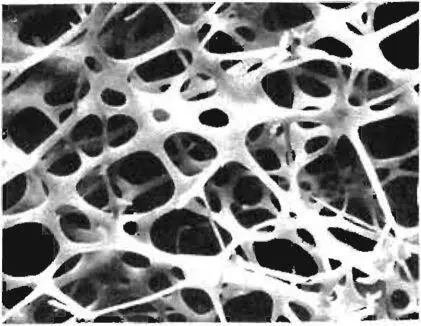 |
| Connections inside a bone. |
A similar column connection can be made integral with poured hollow columns and beams. The forms for the connection are gussets made of skin material: then fill the column and the gussets and the beam in a continuous concrete pour.
Of all the patterns in the book, this is one of the most widespread and has taken the greatest variety of outward forms throughout the course of history. A solid wood capital on a wood column, or a continuously poured column top, and arches of stone, brick, or poured concrete are all examples. And, of course, typical column capitals—a larger stone on a stone column or typical gusset plate or brace—even if weak in some ways, also help a great deal. But only relatively few of the historical column connections succeed fully in acting both as braces and as capitals.
Therefore:
Build connections where the columns meet the beams. Any distribution of material which fills the corner up will do: fillets, gussets, column capitals, mushroom column, and
1071
most general of all, the arch, which connects column and beam in a continuous curve.
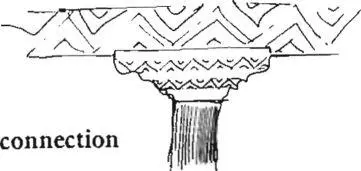
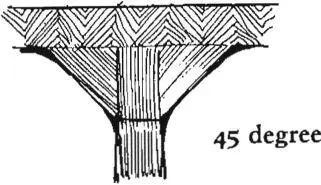
The connection is one of the most natural places for ornament (249): there is a wide variety of possible connections, carvings, fretwork, painting, for this critical position. In certain cases, the connection may act as an umbrella for a column place (226). . . .
| 22 8 STAIR VAULT* |
|---|
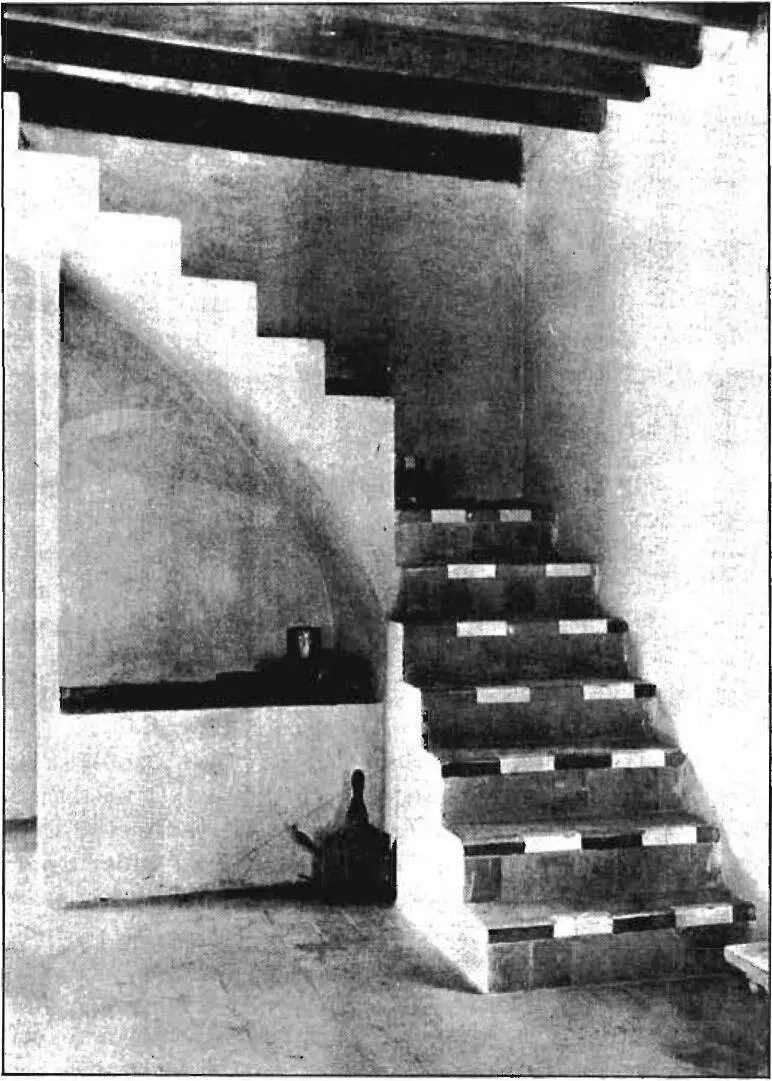 |
1073
. . . this pattern helps complete the rough shape and location of stairs given by staircase as a stage (133) and by staircase volume (195). If you want to build a conventional stair, you can find what you need in any handbook. But how to build a stair in a way which is consistent with the compressive structure of efficient structure (206), without using wood or steel or concrete—good materials (207) ?
*£♦
Within a building technology which uses compressive materials as much as possible, and excludes the use of wood, it is natural to build stairs over a vaulted void, simply to save weight and materials.
A concrete stair is usually made from precast pieces supported by steel stringers; or it is formed in place, and then stripped of its forms. But for the reasons already given in good materials (207), precast concrete and steel are undesirable materials to use—they call for modular planning; they are unpleasant materials to touch, look at, and walk on; they are hard to work with and modify in any relaxed way, since they call for special tools.
Given the principles of efficient structure (206), good MATERIALS (2O7), and GRADUAL STIFFENING (208), We suggest that stairs be made like floor-ceiling vaults (219)—by making a half-vault (to the slope of the stair), with lattice strips, burlap, resin, chickenwire, and lightweight concrete. The steps themselves can then be formed by using wood planks, or tiles, as risers, and filling in the steps with trowelled concrete.
When we first wrote this pattern, we thought it was very doubtful-—and put it in mainly to be consistent with floor and roof vaults!, Since then we have built a vaulted stair. It is a great success —beautiful—and we recommend it heartily.
Therefore:
Build a curved diagonal vault in the same way that you
1074
228 STAIR VAULT
build yourfloor-ceiling vaults (219). Once the vault hardens, cover it with steps of lightweight concrete, trowel-formed into position.
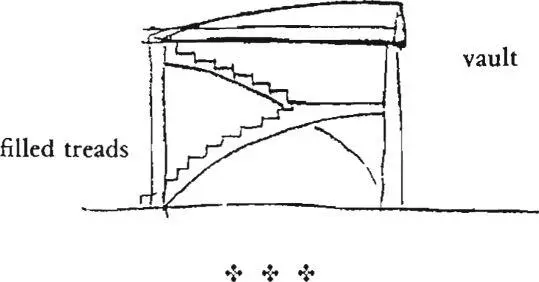
A lightweight concrete tread, colored, waxed, and polished can be quite beautiful and soft enough to be comfortable—see floor surface (233)—and will eventually take on the patina of wear called for in soft tile and brick (248).
The vaulted space under the stair can be used as an alcove (179) a child cave (203), or closets between rooms (198). If it is plastered, like a regular ceiling—see floor-ceiling vaults (219), it makes a much more pleasant and useful space than the space under an ordinary stair.
TOWNS
Therefore:
Break the urban area down into local transport areas, each one between i and 2 miles across, surrounded by a ring road. Within the local transport area, build minor local roads and paths for internal movements on foot, by bike, on horseback, and in local vehicles; build major roads which make it easy for cars and trucks to get to and from the ring roads, but place them to make internal local trips slow and inconvenient.
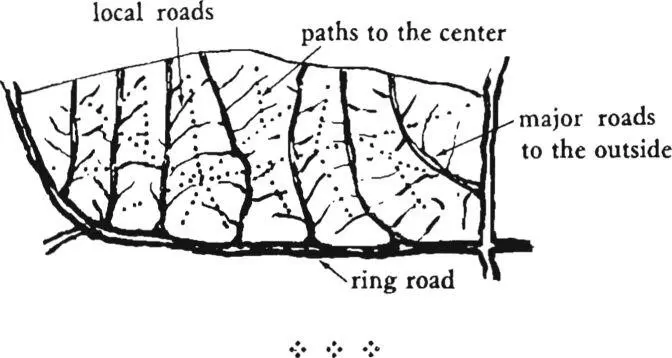
To keep main roads for long distance traffic, but not for internal local traffic, lay them out as parallel one way roads, and keep these parallel roads away from the center of the area, so that they are very good for getting to the ring roads, but inconvenient for short local trips—parai.lel roads (23). Lay out abundant footpaths and bike paths and green streets, at right angles to the main roads, and make these paths for local traffic go directly through the center—green streets (51), network of paths and cars (52), bike paths and racks (56); sink the ring roads around the outside of each area, or shield the noise they make some other way—ring roads (17); keep parking to a minimum within the area, and keep all major parking garages near the ring roads— NINE PER CENT PARKING (22), SHIELDED PARKING (97) i and build a major interchange within the center of the area—interchange (34). . . .
2 29 DUCT SPACE
. . . in a building built according to the principles of efficient structure (206) and built with vaulted floors—floor-ceiling vaults (219), there is a triangular volume, unused, around the edge of every room. This is the most natural place to put the ducts.
•I* *5* ❖
You never know where pipes and conduits are; they are buried somewhere in the walls; but where exactly are they?
In most buildings electric conduits, plumbing, drains, gas pipes, telephone wires, and so on, are buried in the walls, in a completely uncoordinated and disorganized way. This makes the initial construction of the building complicated since it is difficult to coordinate the installation of the various services with the building of various parts of the building. It makes it difficult to think about making any changes or additions to the building once it is built since you don’t know where the service lines are. And it leaves a gap in our understanding of our surroundings: the organization of utilities and services in the buildings we live in are a mystery to us.
Читать дальшеИнтервал:
Закладка:
Похожие книги на «A pattern language»
Представляем Вашему вниманию похожие книги на «A pattern language» списком для выбора. Мы отобрали схожую по названию и смыслу литературу в надежде предоставить читателям больше вариантов отыскать новые, интересные, ещё непрочитанные произведения.
Обсуждение, отзывы о книге «A pattern language» и просто собственные мнения читателей. Оставьте ваши комментарии, напишите, что Вы думаете о произведении, его смысле или главных героях. Укажите что конкретно понравилось, а что нет, и почему Вы так считаете.












